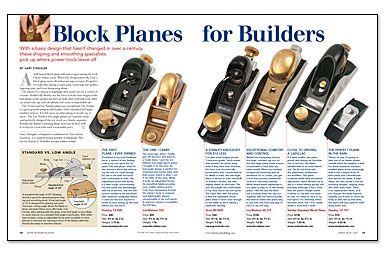Block Planes for Builders
With a basic design that hasn’t changed in over a century, these shaping and smoothing specialists pick up where power tools leave off.

Synopsis: Block planes might seem like tools better suited for a woodshop than a job site, but veteran carpenter and builder Gary Striegler finds plenty of uses for block planes. Striegler offers comments on six block planes that he finds useful when he’s working on a house. Ranging in price from $10 to $150, the planes are helpful for a variety of tasks, from tuning up a miter joint to sharpening shims.
A well-honed block plane still earns a spot among the tools I keep within reach. When I’m doing trimwork, I use a block plane more often than my tape measure. It’s perfect for tasks like tuning a miter joint, removing saw marks, tapering trim, and even sharpening shims.
The planes I’ve chosen to highlight here stand out for a variety of reasons. Neither the Stanley nor the Groz is in the same league as the best planes on the market, but they are both solid, well-built tools. After an initial tune-up, each should provide years of dependable use.
The Veritas and Lie-Nielsen planes are exceptional. The Veritas is a great general-purpose block plane with a standard bed angle. If I did more woodworking, I would use it more. The Lie-Nielsen low-angle planes are expertly made and perfectly designed for my work as a finish carpenter. Finally, the Stanley trimming plane wows me by how well it works for a tool with such a reasonable price.
Standard vs. low-angle
A standard bed angle of 20° is good for general-purpose shaping and smoothing work. A low bed angle of 12° is designed for planing end grain. The lower cutting angle allows the blade to shear end-grain fibers more effectively. Conversely, when planing with the grain, a low bed angle is more likely to cause tearout, so a standard bed angle is preferable. With either type of plane, using an adjustable throat plate (available in some planes) to minimize the opening in front of the blade (called the throat) also helps to minimize tearout.
A Stanley knockoff for $10 less
I’ve seen some bargain-priced “contractor-grade” block planes that wouldn’t be worth using even if they were free. However, the Groz is an economically priced plane that I would hold on to. Made in India, this low-angle plane is almost an exact knockoff of Stanley’s version, but with slightly better fit and finish. The size and weight felt comfortable in my hand and in my tool apron. The major flaw with this plane is that the adjustable throat plate doesn’t move close enough to the blade to aid in taking a super-thin shaving.
Exceptional comfort and control
Made from manganese bronze, the large, rounded cap iron on this low-angle plane made it more comfortable to hold than any other model. When you combine exceptional machining with an extrathick (3⁄16 in.) blade, you get a tool that provides unmatched control in removing material. While lateral blade adjustment is not quite as easy as on the Veritas plane, I like the way the feed nut is tucked under the cap iron. Together with the narrow profile, this feature makes this plane easy to use with one hand and easy to carry in my tool bag.
For more photos and details, click the View PDF button below:


























